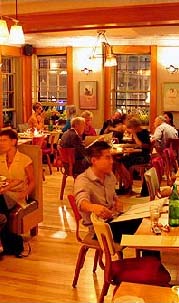
Chris Cannon and Micheal White, owner & chef respectively of the new restaurant Marea, are too smart to actually announce that they are gunning for four stars. That hasn’t stopped others (Ben Leventhal, Mister Cutlets) from making ambitious predictions on their behalf, but Messrs. Cannon and White have been wisely silent.
You just know it’s true, though. White has earned three NYT stars on a trio of occasions—at Fiamma Osteria, where he no longer works, and at Alto & Convivio, where he still does. You just know he wouldn’t have signed up for $700,000 in annual rent and a luxurious make-over of the old San Domenico space, if all he wanted was another three-star restaurant.
When I saw the opening menu, my heart sank: it featured over 85 items in almost a dozen categories. No three- or four-star restaurant tries to serve so many things, especially in the early days. It is often a recipe for disaster; it is seldom a prescription for excellence.
When we visited on Saturday evening, we found a menu slightly simplified, but it still offered over 70 items, or about double what it should, even allowing that some of them are crudi or raw bar selections that require minimal preparation. The unfortunate result was predictable: rubbery squid; cold pasta; over-cooked sturgeon.
The restaurant also has the same problem that plagued San Domenico: it is a large space, and it is difficult for a kitchen to keep up, especially when so many of the dishes are as overwrought as they are here. We know that Michael White can cook, but predictions that he would get four stars out of the gate seem to us premature—that is, assuming Frank Bruni doesn’t have a lobotomy between now and August.
Marea means tide in Italian, and the cuisine is all seafood, aside from a couple of bail-out dishes for landlubbers. The menu is hedged for the economy, as it naturally would be. It suggests, in small print, the four-course prix fixe at $89. You can still order à la carte and get out for less money, although by no means cheaply.
Just to list all of the menu categories is exhausting: snacks to share ($9–14); crudi ($11–17, or $23 for three); six kinds of oysters ($3.50 ea.; $35 per dozen); caviar; antipasti ($17–24); primi and risotti ($24–36), secondi ($35–47), whole fish & shellfish ($39–49 per pound). The whole fish offer a choice from among four sauces and six sides; there seems to be no way to order the sides separately.
It took us quite a while to absorb all of this. The $89 prix fixe precludes the whole fish; you can choose one antipasto or crudo, one pasta or risotto, and one secondo, though a number of them carry supplements. We finally decoded the whole menu and were ready to order.
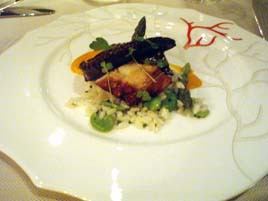

Polipo, or grilled octopus (above left) was a rubbery disaster, rendering irrelevant the bed of rice, fava beans, and yellow tomatoes on which it lay.
Tartare of Hawaiian blue prawns, chanterelles, and almonds (above right) was fine, but a bit flat. The almonds were draped casually over the top of the tartare, but not really integrated in the dish. We had similar misgivings about most of the things we tried.
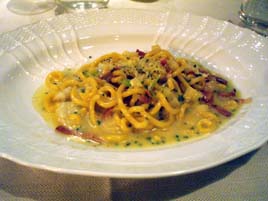
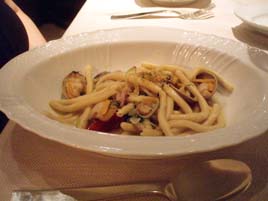
Gramigna (above left) caught my eye because it wedded smoked cod and speck, along with leeks and gremolata. It was the more successful of our two pastas, but for the life of us we couldn’t detect any smoked cod. “I wonder if they forgot it,” my girlfriend remarked.
Ferratini (above right) arrived not warm enough, and it also suffered from poorly calibrated ingredients. It allegedly contained manila clams, calamari, and hot chilies, but the latter ingredient was singular. We counted just one chili, and it contributed nothing to the flavor of the dish.

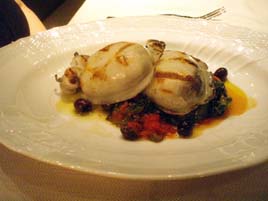
A long wait ensued for the secondi. We were in no hurry, but the delay foretold another culinary misfire. Storione, or Columbia river sturgeon (above left) arrived tasting like dry sponge, along with another miscellaneous mixture of ingredients—chanterelles, spring garlic, and citrus.
Seppia, or grilled Mediterranean cuttlefish (above right) seemed to have been correctly prepared, and it was somewhat more intriguing, as one is seldom served the whole animal. But again, it had little to do with its dance partners: braised escarole, livornese sauce, and wild oregano.
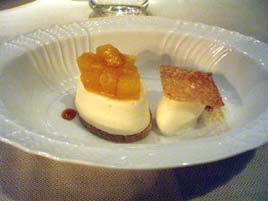
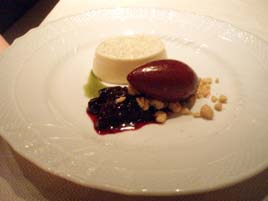
Dessert was the only fully successful course: a pineapple cheesecake with coconut sorbet (above left); a panna cotta with blueberries (above right). [This is the only course for which I do not have a printed menu, so these descriptions might not be quite right.]
There were no amuse courses, as one normally expects at a restaurant serving an $89 prix fixe. The breads were excellent, especially a focaccia; at the end, a meager quartet of chocolate petits-fours was yet another reminder of the amenities Marea still lacks, in light of its price range.
When the kitchen is under control, Marea will be a lovely place to dine. The multi-million dollar rehab of the dowdy old San Domenico space is stunning, without being ostentatious. You can’t avoid noticing how lovely it is, but it doesn’t get in your way. The serving pieces are lovely too, including a gorgeous charger plate I’d love to take home.
The staff render polished service. The lengthy wine list has plenty for the $50-and-under crowd (like us). A sommelier visited our table unbidden and immediately directed us to a happy choice in our price range. When we got home, I realized I hadn’t taken a copy of the menu and would have no hope of remembering all of the Italian names and ingredients. I called the restaurant back, and they emailed it to me that same evening. At 12:15 a.m.
We do not doubt that Marea is capable of turning out multi-star food. On some days, and for some guests, it may be doing so now. But nothing we tried, even had it been executed properly, approached the potential of the city’s gold standard for seafood, Le Bernardin. Perhaps it is a disservice to Michael White that anyone suggested Marea was in the same league.
Sadly, Chef White now cannot take the one obvious step that would improve Marea tremendously, which is to cut the menu in half. That would smell of desperation—admitting defeat just as the critics are starting to take their measure of the place. So he will continue to tinker around the edges and hope that he can send out winners when he has to.
Marea (240 Central Park West between Seventh Avenue & Broadway, West Midtown)
Food: *
Service: **½
Ambiance: ***
Overall: **

 Wednesday, June 17, 2009 at 04:51PM
Wednesday, June 17, 2009 at 04:51PM  Alain Ducasse,
Alain Ducasse,  Benoit,
Benoit,  Pierre Schaedelin,
Pierre Schaedelin,  Rye in
Rye in  Review Recap
Review Recap 




































